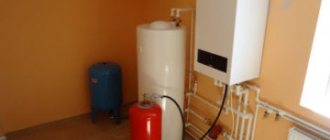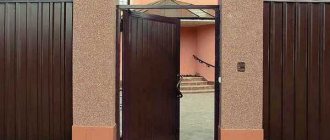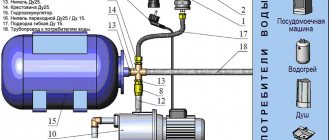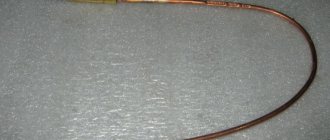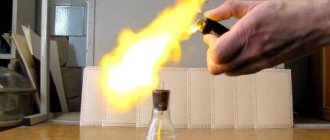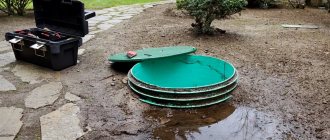When ordering the installation and connection of complex equipment for their country house, few owners delve into how it is designed and functions. Most rely on the experience of installers and the literacy of service workers. But many units only seem complex and incomprehensible, when in fact they are very easy to understand. Such equipment includes the Topas 5 septic tank, the operating principle and design of which are easy to understand. Having understood them, you can independently identify faults, maintain and repair the structure, saving not only money, but also time.
You can do the cleaning and minor repairs of the septic tank yourself Source topas-septiks.ru
General information
The performance of Topas septic tanks varies. When purchasing, focus on the number in the model name. For example, Topas 5 is intended for cleaning household wastewater from five people, and Topas 9 - from nine, subject to a daily water consumption of 200 liters for each person. This is the average volume of water adopted in the standards. That is, model 5 is capable of processing 1 cubic meter of wastewater per day.
However, it is necessary to take into account such a concept as peak or salvo discharge. This is the volume of liquid that can enter the receiving chamber of the structure in a short period of time. The dimensions of this chamber, which differ for each model, must be sufficient to simultaneously receive a large volume of water, since the principle of operation of the Topas septic tank involves the gradual processing of wastewater with its movement to the next compartment only after initial settling.
In Topas 5, the volume of the receiving compartment is 220 liters Source ruza.burenie-skvazhin-cena.ru
Having several bathrooms in the house, you need to take into account that the volume of a full bathtub can already fill the septic tank, so you should not drain two or more at the same time, while starting the washing machine and washing dishes in the sink.
How does it work
To understand how the Topas septic tank works, you need to study its structure. It is similar for all household models, only the volumes of the compartments and their relative positions differ.
Scheme of the structure Source tildacdn.com
In total, in a common housing under the lid there are four separate chambers for step-by-step sewage treatment and a box designed to accommodate compressors and a control unit.
- The wastewater is drained into the receiving chamber A through pipe 1 coming from the house.
- At the bottom of the chamber there are aerators 16 connected to a compressor 6 and generating air flows.
- The dirty liquid is mixed under the influence of air, crushing large inclusions.
- When compartment A is filled, float sensor 9 is activated.
- The largest uncrushed fractions are retained by filter 2 and remain in the receiving compartment until dissolved, and pump 3 pumps the liquid into the next chamber - aeration tank B.
- On the way to the aeration tank, a hair trap 7 is installed, which does not allow insoluble contaminants to pass into it - fabric fibers, hair, films.
- This compartment also has aerators, the function of which is to saturate the contents with oxygen to support the vital activity of aerobic bacteria present in any household waste.
Aerobic bacteria are primitive single-celled microorganisms Source cleanshop.ru
- Microorganisms actively process waste liquid, purifying it and separating it from sludge.
- While still mixed with the sludge masses, the water is poured into the secondary settling tank B, where heavy sludge settles to the bottom, and the settled liquid is poured out through pipe 8, having previously gone through the last stage of purification through a thin filter 13.
On a note! For a Topas septic tank, the operating principle may differ depending on the method of discharging purified water. If it cannot be drained by gravity, the station will be equipped with an additional drainage pump.
- The sludge that has settled to the bottom of the aeration tank and secondary settling tank is pumped into the last compartment G, from where it is periodically pumped out and disposed of.
Sludge masses can be placed in compost for processing into fertilizer or removed using sewage disposal equipment. Effluent clarified by 96-98% is used as process water - for washing paths, cars, watering ornamental plants, shrubs and trees. Green plants, as well as vegetable and berry crops during their ripening period cannot be watered with such water, since it is not bacteriologically safe.
Purified water is poured into drainage ditches or storage tanks for subsequent use Source eko-centr.ru
See also: Catalog of companies that specialize in engineering systems (heating, water supply, sewerage and others) and related work
What is it made of?
The main requirements for the walls of septic tanks buried in the ground are their strength, resistance to soil moisture and aggressive substances contained in wastewater. All these qualities are possessed by sheet polypropylene, from which both the body and the internal partitions of the Topaz septic tank are made. How this polymer material works under harsh operating conditions can be seen in the example of polypropylene pipes, which are laid both underground and in concrete screed.
For the outer walls of the housing, sheets with a minimum thickness of 18-20 mm are used, since they experience serious soil pressure. The partitions that form the internal chambers are made from sheets with a smaller thickness. They are connected to each other using semi-automatic welding. Sheet bending is also used to reduce the number of seams.
Welding polypropylene Source tibb-ev.de
Like all other types of plastics, polypropylene is not destroyed by water and aggressive sewage. It is plastic and can return to its original shape after minor deformations. And its low thermal conductivity and ability to retain heat allows you to do without additional thermal insulation of the body.
What is equipped with
The design of the Topas septic tank is such that it only works when connected to electricity that powers various equipment. The standard set includes:
- float switch;
- compressors;
- Control block;
- circulation pump;
- transfer pump.
Models with forced pumping of purified water are also equipped with a drainage pump.
All electrical equipment is of high quality and economical energy consumption. For example, German-made Wilo pumps are used to pump liquid from a septic tank, and Airmac compressors with a power of 60 W are used to pump air, which, when operating alternately, consume only 45 kW of electricity per month.
Air compressor Airmac DB-60 Source amursk.tarabaza.ru
The rest of the components also belong to well-known brands. They are easily dismantled for maintenance, repair or replacement, which is why the Topaz system, which differs from similar stations in its simplicity and reliability of design, is so popular.
Recommendations for use
In order for the septic tank to work properly and for a long time, it should be used in accordance with the rules established by the manufacturer. It is necessary to avoid moving various inorganic waste into the sewer system, for example, plastic, polyethylene, construction waste, etc.
Correct installation of the Topas septic tank is extremely important for the further successful operation of an autonomous sewage system of this type. Failure to comply with recommendations may result in destruction of the device's capacity.
Such substances are not amenable to bacterial processing, so in the best case they will simply settle in the septic tank, reducing its useful volume and productivity. In the worst case, the presence of inorganic contaminants can lead to damage to the septic tank or equipment failure.
A detailed overview of common breakdowns of the Topas septic tank and methods for eliminating them are discussed in this article.
It is not recommended to pour substances that contain antibiotics, as well as chlorine or manganese compounds, into the sewer, since this creates an environment hostile to bacterial cultures and they may simply die.
If the number of bacteria in the septic tank decreases noticeably, waste processing will slow down, and an unpleasant odor will appear in the septic tank.
For the same reasons, it is not allowed to use a septic tank for the disposal of large quantities of alcohol-containing liquids, technical oils, antifreeze, acids or alkalis of high concentration, for example, household cleaners.
Do not put wool down the drain. Although it is an organic substance, it cannot be processed quickly enough in the septic tank, but it can cause a clog in the unit.
Regular removal of neutral sludge accumulated at the bottom of the Topas septic tank is an important part of maintaining the device, ensuring its uninterrupted operation
Problems can also arise as a result of a power outage. If the septic tank does not work and waste continues to flow, this will cause the tank to overflow, resulting in the entry of untreated mass into the soil.
During short power outages, it is recommended to reduce the amount of waste entering the sewer system as much as possible. In case of prolonged outages, an alternative source of electrical energy should be provided.
Regular maintenance of the septic tank will help you notice problems in time and prevent possible problems. The purity of the water obtained as a result of purification should be checked from time to time.
If the amount of pollution increases, you should find the cause and eliminate it: adjust the operation of the septic tank, update the composition of bacterial cultures, etc.
About three or four times a year, accumulated sludge should be pumped out of the container using a special hose, and the container in which unprocessed waste accumulates should also be cleaned. Every two years, compressor membranes must be replaced with new ones in order for these mechanisms to work correctly.
But filters require replacement monthly; they get dirty quickly. The aerator is rarely replaced - every 12 years, but this measure should not be neglected.
If the septic tank will not be used in winter, it must be properly preserved.
It should be understood that this is not a heating system; complete pumping of liquid from the septic tank will have a detrimental effect on the bacteria inhabited in the device. Before preservation, the device is cleaned and left partially filled with water.
Modifications and markings
Topas cleaning stations are produced in different modifications, which allows you to choose the best option both in terms of cost and installation and operating conditions. Changes in design do not affect the general operating principle.
Number of compressors
The installation operates in two modes:
- direct mode of wastewater treatment and treatment;
- reverse mode of activated sludge regeneration.
When liquid enters the receiving compartment, the septic tank operates in direct mode. When the receiving tank is empty, the float switch starts the reverse mode, allowing the vital activity of aerobic bacteria inhabiting the activated sludge to be maintained.
Standard septic tanks are equipped with two compressors, each of which is responsible for its own operating cycle. The more budget-friendly Topas-S station is equipped with one compressor and a solenoid valve responsible for redistributing air when changing modes.
An installation with one compressor is cheaper Source septik-dlia-dachi.ru
The disadvantages of a single-compressor scheme include a higher probability of equipment failure, which works without interruptions and “for two”. In addition, for correct operation of the solenoid valve in conditions of unstable electricity supply, it is recommended to install a voltage stabilizer.
Why is activated sludge needed?
Activated sludge is a mixture containing microorganisms that carry out purification. Under the influence of bacteria, further decomposition of feces occurs. For them to function, there must be oxygen in the environment. In this station, the elimination of organic matter is carried out by aerobic bacteria, provided with oxygen using equipment.
Biological cleaning with sludge in combination with fine-bubble aeration allows you to get a good effect. As a result of the work of bacteria, the water after purification becomes clean and transparent. Bacteria that destroy organic components are completely harmless and multiply quickly.
Video description
A visual comparison of the Topas and Topas-S models is shown in the video:
Pipe entry height
The level of entry of a sewer pipe into a sanitary hydraulic structure depends on many conditions: the distance from the house to the septic tank, the topography of the site, the height of the groundwater, the depth of freezing, etc. To fit into any conditions, several modifications of the device with different heights have been developed.
- Standard - suitable for inserting a pipe at a distance of no more than 0.8 m from the ground surface.
- Long - a body with an elongated neck and a drain pipe inlet at a height of 0.8-1.4 m from the ground.
- Long Us is a modification with reinforced body walls that can withstand soil pressure at great depths, with the ability to insert pipes at a height of more than 1.4 m.
The difference between Topas modifications lies in the level of pipe entry Source septik-good.ru
For reference! The reinforced version has standard dimensions, but allows you to extend the neck for installation to the desired depth.
Effluent discharge method
In fact, the Topas sewerage system is not a septic tank in the literal sense of the word, since it does not require additional wastewater treatment with the installation of filtration fields and other additional structures. This is a treatment plant that carries out a full processing cycle: the purity of the liquid at the outlet reaches 98%, so it can be safely poured into ditches or used for irrigation.
Depending on the height at which the purified water exit point is located in relation to the storage tank or drainage channel, it flows out by gravity or is forcibly pumped by a pump. Modifications equipped with such a pump have an additional Pr index in the marking.
Devices with forced pumping are equipped with an additional compartment for installing a drainage pump Source mosseptic.rf
Electrical circuit Topas
The supply cable is supplied in the compressor compartment. You only need to connect it to the control unit. The Topas connection diagram differs slightly from model to model. The following circuit diagrams are used in septic tanks from Topas-4 to Topas-30.
You can also look at the electrical diagram of the Topas analogue. It is more understandable for the average user.
How to connect a septic tank to the electrical network
As you can see, the Topas connection diagram is very simple and any electrician can figure it out. Or you can buy a Topas control unit assembled: with sealed sockets, with sealed leads that will prevent moisture from getting inside the case.
Installation and maintenance
For installation and connection of the unit, lifting equipment and complex tools are not required; this work can be done independently.
The Topas biological treatment station is installed vertically and does not take up much space on the site. To install it, a pit is torn to such a depth that after installing the housing on a sand cushion 15 cm thick, only the upper part with a lid 18-20 cm high rises above ground level.
The size of the pit should be 20-30 cm larger than the septic tank Source septik-centr76.ru
Using the eyes on the body, the installation is lowered into the pit on ropes, the pipes are leveled and cut into place. Then the empty space behind the walls is filled with sand, while simultaneously filling the chambers with water.
It is better to entrust commissioning work with connecting and checking the operation of equipment to specialists.
Features of preserving a septic tank for the winter
Effective operation of the system is possible if the microflora is supported with nutritional components in the form of fecal waste. Otherwise, beneficial organisms will die. If the installation of the equipment was carried out correctly, it will not be afraid of frost.
Before winter, the Topas septic tank is specially preserved. To protect equipment from the formation of ice in containers, the hatch should be insulated. The sealing material used is polystyrene foam, mineral wool or hay.
It is important to follow the following rules:
- The hatch should be opened quickly. This will prevent the containers from freezing.
- It is not recommended to drain the system during cold weather. Since the soil is constantly moving, it can push the septic tank to the surface and cause pipe failure.
- Elements that are on the surface should be removed.
Preservation is carried out if the equipment will not be used for several months. For normal support of the vital activity of microorganisms, the installation can be used 1-2 times a week.
Stages of preservation of the Topaz septic tank for the winter
Before the procedure, it is recommended to turn off all water taps and stop using the sewer.
Preservation of a topas septic tank for the winter includes the following steps:
- Turn off the power supply to the equipment. To prevent the device from accidentally starting, it is better to disconnect it from the package switch.
- Liquids from the tanks are pumped out so that all devices remain on the surface. Then the collected debris is removed. This can be done with a brush.
- Disable auxiliary mechanisms. Devices must be folded very carefully so as not to cause harm to them.
- Before disassembling, it is recommended to sketch out a diagram so as not to confuse the parts when assembling.
- Then the containers should be filled 75% with water.
- After this, the hatch is insulated. It is important to protect the material from precipitation, since only dried insulation will function.
- The removed device is cleaned, lubricated and disassembled. Individual elements should be wrapped in dry cloths and stored in a dry room.
If the building is not planned to be heated during the cold season, then it is recommended to move the devices to another heated room. After these manipulations, the microorganisms fall into a state of suspended animation.
And with warming, they will quickly return to working condition. To stimulate this process, you can add a little kefir to the container. The station is being put in order after the heat has stabilized.
After installing the equipment, the system is filled with water and started up. The bacteria will acquire their properties within a couple of days after connection.
Video description
How to install and connect, watch in the video:
Proper and uninterrupted operation of the station is possible only with regular maintenance. A service agreement can be concluded with the supplier company, but it is not difficult to carry it out on your own. To do this, once every 3-4 months you need to remove sludge from the last chamber, wash filters, airlifts and compartment walls, and clean the hair trap. And every two years, change the compressor membranes.
Cleaning walls with high pressure water Source perm.net-zasoru.ru
Aerator nozzles also need to be cleaned, and every 8-10 years, air blowers need to be replaced with new ones.
Briefly about the main thing
As you can see, the device of Topas 5 and other wastewater treatment plants of this brand is quite simple. Sewage waste, entering it, goes through several stages of processing - mixed until homogeneous, filtered, exposed to aerobic bacteria, settled and separated into purified water and sludge. The output is process water and sludge, which are quite suitable for fertilizing the soil. You can select the device according to the installation level and the method of discharging wastewater outside, for which different modifications of the same power are produced.
Principle of operation
Bioseptic Topas is an autonomous station for biological treatment and filtration of wastewater, which operates thanks to a filter with a certain bacteriological background (content). This is an ideal solution for a country house or cottage, since anaerobic bacteria do not cause any harm to the environment and do not disturb the biological climate of the area. This septic tank is completely autonomous, i.e. it does not require a connection to the network and operates thanks to exclusively mechanical spare parts.
Photo - design
The principle of operation of the Topas septic tank is based on multi-chamber wastewater treatment. From the sewer, water enters the installation chamber of the structure. Primary conservation and filtration of wastewater is carried out here. At this stage, the device separates solid fecal matter or other particles from liquid ones and settles them. The compressor then pumps the liquid into the second chamber. It is here that the sewage system is exposed to bacteriological compounds that purify and filter the liquid.
Photo - drawing
During operation of this septic tank, silt and other solid particles settle in the chambers. After cleaning is completed, they are further filtered and melted into a pyramid, which is a classic settling tank. The Topas septic tank is very easy to use; its maintenance does not include any additional measures other than inspecting and cleaning the septic tank.
Photo - principle of operation
Advantages of a septic tank:
- Easy to use;
- Cleaning efficiency reaches 99%. For comparison, many other products do not purify water by more than 60%;
- Complete security;
- Durability of work. Average service life is more than 30 years;
- The sludge that settles at the bottom of the settling chamber does not enter the rest of the liquid and is often used by home owners to fertilize the site;
- You can make the connection yourself.
Photo - general view of Topas 3
Disadvantages that a Topas septic tank type system from Topol has:
- High price. The price is determined by the need to use special aerobic bacteria. The same manufacturer has a more affordable analogue - Topas Bioxi, which uses other microorganisms;
- Regular maintenance is required to ensure efficient operation. This includes cleaning the sump, checking the condition of the chambers and the bacteriological filter;
- For preventive cleaning, you need to use special mild detergents.
For example, for cottages with more than 5 people living, the Topas 8 system is used; it needs to be cleaned once a month. Topas 5 is cleaned once every 2 months. In addition, in winter it is necessary to carry out additional insulation of the systems, since bacteria can be damaged as a result of hypothermia.




